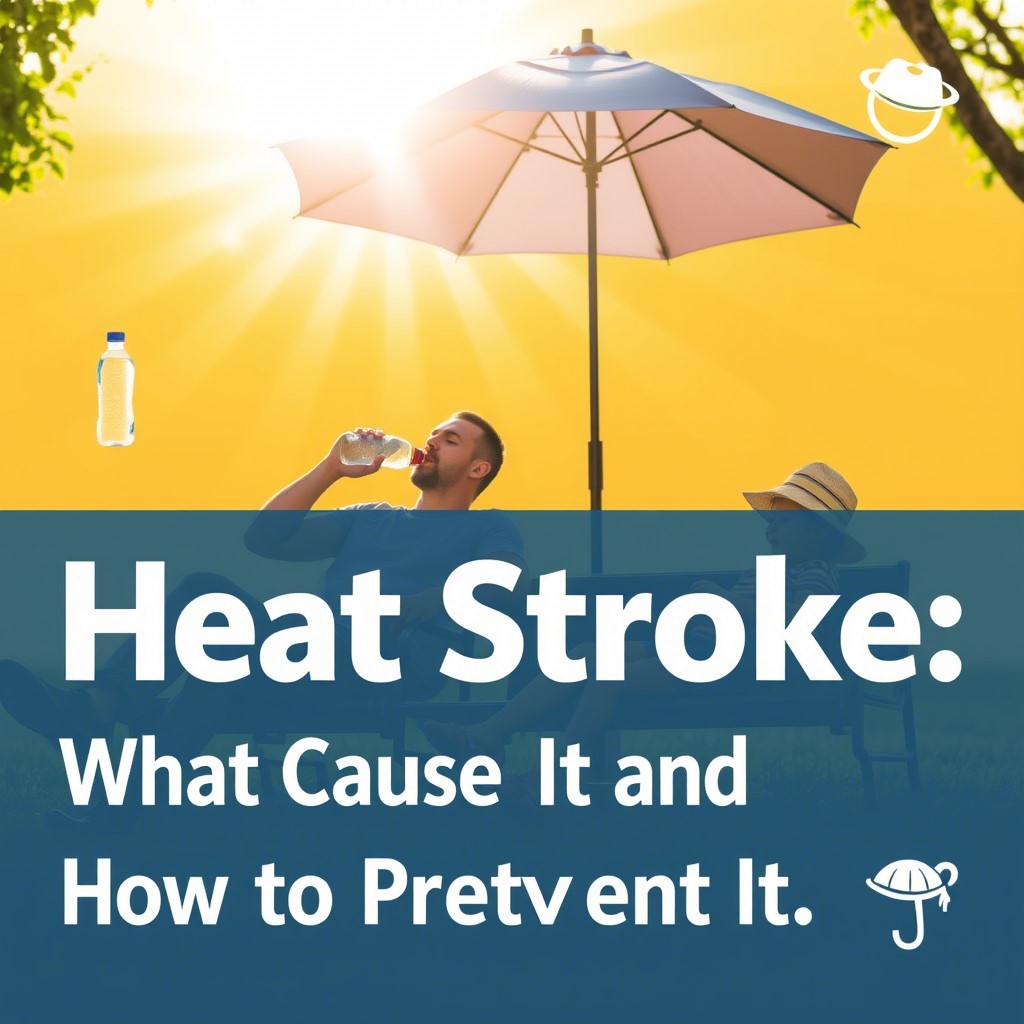Heat stroke is a dangerous condition when your body gets too hot. It can make you feel sick, confused, or even faint. It happens in hot weather and can be life-threatening. To fix it, cool down fast and get help. Drinking water and staying in the shade prevents it. This article explains heatstroke, its causes, signs, and easy ways to stay safe. I’ve seen how simple steps save lives in summer, and I’m eager to share these tips with you
What Is Heat Stroke?
When your body overheats past 104°F and can’t cool down, it may damage vital organs like the brain, heart, or kidneys. It’s the most severe of heat-related illnesses. I like to think of it as your body’s cooling system failing in extreme heat. Kids, seniors, and active people are at higher risk. Knowing about summer heat dangers helps you act fast.
Types of Heat Stroke
Heat-related illnesses come in two main types. Knowing them helps you understand how to spot and prevent it. I like breaking this down because it makes heatstroke less confusing.
1. Exertional Heat Stroke
This type happens during intense activity in hot weather. Athletes, workers, or kids playing hard can get it. Physical activity in the heat pushes the body too far, raising temperature fast. I’ve seen runners collapse from this during summer races. It’s common for young, active people.
2. Non-Exertional Heat Stroke
This type affects people who aren’t active, like seniors or babies, in hot conditions. It builds slowly, often in heatstroke in children and older adults. Poor cooling, like no air conditioning, causes it. I’ve noticed this in heat waves when homes get too hot.
Why Is Heat Stroke So Serious?
Left unchecked, it can trigger confusion, seizures, or be fatal. It’s not just feeling hot; it’s an emergency treatment for a heatstroke situation. I’ve read stories of people collapsing during heat waves, and it’s scary how fast it happens. Early action saves lives.
What Causes Heat Stroke?
Sunstroke warning signs happen when your body can’t handle the heat. Here are the main summer heat dangers:
1. Hot Weather and Humidity
High temperatures, especially above 90°F (32°C), trigger a high body temperature. Humidity stops sweat from cooling you. Heat wave safety is key during summer. I’ve felt how sticky days make it hard to stay cool.
2. Dehydration
Not drinking enough water leads to dehydration and overheating. Water helps your body sweat and stay cool. I’ve seen kids forget to drink while playing outside, raising summer heat dangers.
3. Intense Activity
Running, sports, or hard work in the heat causes overheating in summer. Your body makes extra heat, and without breaks, it’s too much. I’ve noticed that athletes push too hard in physical activity in the heat, which is risky.
4. Heavy Clothing
Thick clothes trap heat, blocking cooling. Construction workers or kids in heavy uniforms face higher temperature health risks. I’ve seen people sweat more in the wrong clothes, increasing heatstroke.
5. Health Conditions or Medicines
Some illnesses, like heart disease, or medicines make cooling harder. Seniors and kids are more at risk for high body temperature in children and older adults. I’ve read about medicines that raise body temperatures in hot weather.
Signs of Heat Stroke to Watch For
Spotting high-temperature health risks symptoms in adults and children can save lives. Here are key signs of heat-related illness:
1. Very High Body Temperature
A key red flag: body temp climbing past 104°F (40°C).. Skin feels hot and dry, not sweaty. I’ve seen how fast this happens on hot days.
2. Confusion or Dizziness
Heat stroke can make you feel confused, dizzy, or slur words. You might act strange or faint. I’ve heard of people getting lost in thought during heat-related emergencies.
3. Fast Heartbeat
Your heart races or pounds hard. This happens as your body fights to cool down. I’ve noticed this in kids running too long in the sun.
4. Nausea or vomiting
Feeling sick or throwing up is common. Heat exhaustion symptoms can turn into heat stroke if ignored. I’ve seen people push through feeling bad, which is dangerous.
5. Headaches or Cramps
A strong headache or muscle cramps signal a high body temperature. These are early sunstroke warning signs. I’ve felt headaches when I didn’t drink enough water in the heat.
What Are the Risk Factors for Developing Heat Stroke?
Some people face higher high temperature health risks for heatstroke. Knowing this helps you protect yourself and others. I’ve seen how certain factors make a big difference, so let’s break them down.
1. Age
Kids and seniors are more at risk. Heatstroke in children and older adults happens because their bodies don’t cool well. Kids overheat fast, and seniors sweat less. I’ve checked on my grandparents during heatwaves to keep them safe.
2. Intense Activity
Hard exercise or work in the heat causes overheating in hot weather. Athletes or outdoor workers, like construction crews, face this. I’ve noticed runners forget to take breaks, which is dangerous.
3. Health Conditions
Conditions like diabetes or heart issues reduce the body’s ability to cool itself.. Some medicines, like diuretics, increase dehydration and overheating risks. I’ve read about medicines causing problems in the heat.
4. Hot Environments
Living without air conditioning or fans raises heatstroke. Heat wave safety is tough in hot homes or cars. I’ve seen people struggle in stuffy rooms during summer.
5. Not Drinking Enough
Skipping water leads to heat-related dehydration signs. If you don’t hydrate, your body can’t cool itself. Kids often get so caught up playing, they skip drinking water.
Complications of Heat Stroke?
Heatstroke is serious because it can harm your body. If not treated, it causes effects of heat on the brain and organs. I’ve read about cases where quick action prevented worse outcomes. Here are the major complications.
- Heatstroke may harm vital organs as the brain, heart, or kidneys. Organ failure risks are high if your temperature stays too high. I’ve seen stories of long-term kidney issues from untreated cases.
- Seizures: High heat can cause seizures, especially in kids.It’s alarming—and a clear sign for parents to take quick action.
- Coma or Death: In severe cases, heat stroke can lead to a coma or be fatal. Emergency treatment for heatstroke is critical to avoid this. I’ve read about close calls where cooling saved lives.
- Long-Term Health Issues: Even after recovery, some face muscle, or nerve problems. I like how early heat stroke treatment can prevent this.
These risks show why heatstroke needs quick action.
Diagnosis and Tests
Doctors diagnose heatstroke by checking symptoms and your health. I’ve seen how fast they work to confirm it, which saves time. Here’s how they do it.
- Temperature Check: Doctors measure your body temperature. A reading above 104°F (40°C) suggests a high body temperature emergency. They use a thermometer for accuracy.
- Symptom Review: They ask about dizziness, nausea, or confusion. Signs of severe sun exposure help them decide. I’ve read doctors ask about recent heat exposure.
- Blood or Urine Tests: These check for organ damage and dehydration symptoms. They show if the kidneys or muscles are hurt. I like how tests give clear answers.
- Heart or Brain Scans: In severe cases, doctors may use ECGs or CT scans to check for effects of heat on the brain and organs. This is rare but thorough.
If you suspect heatstroke, get to a doctor fast. They’ll confirm and start emergency treatment.
Management and Treatment
Treating heatstroke is urgent. The goal is to cool the body and prevent harm. I’ve seen how quick action makes a vast difference. Here’s how it’s done.
1. Immediate Cooling
Move the person to shade or air conditioning. Cool down fast with damp cloths, ice packs, or a bath—focus on the neck, armpits, and groin. Cooling down the body fast is key. I’ve read about ice baths saving athletes.
2. Hydration
If the person is alert, give small sips of water or electrolyte drinks. Avoid forcing too much liquid. Stay hydrated tips help recovery. I’ve seen this work for mild cases.
3. Medical Care
Hospitals may use IV fluids or cooling blankets for emergency treatment for heat stroke. Doctors monitor organs to prevent organ failure risks. I like how hospitals act fast to stabilize patients.
4. Rest and Recovery
After treatment, rest is crucial. Avoid heat for days to weeks. I’ve noticed people feel better with rest and hot weather safety tips post-recovery. Think it’s heatstroke? Get emergency help right away.
How to Prevent Heat Stroke
High-temperature health risks prevention is easy with these steps. I’ve tested these tips, and they work.
1. Drink Plenty of Water
Sip water every 15-20 minutes in the heat. Avoid sugary drinks; they don’t hydrate well. I carry a water bottle on hot days, and it keeps dehydration symptoms away.
2. Wear Light, Loose Clothes
Choose light-colored, loose outfits. They let your body cool down. I like wearing a white shirt in summer because it feels cooler. This lowers heatstroke risk.
3. Rest in Shade or Indoors
Rest in cool shade, or AC every half hour to stay safe. I’ve seen families use umbrellas at parks, which helps with staying cool during heat waves.
4. Avoid Peak Heat Hours
Stay inside from 10 a.m. Around 4 p.m., the sun hits its peak intensity. Plan outdoor fun for early morning or evening. I’ve noticed it’s safer and cooler then.
5. Use Fans or Air Conditioning
Cool spaces prevent overheating in hot weather. A fan or air conditioning makes a big difference. I’ve felt how a small fan cools a hot room fast.
6. Check on Vulnerable People
Kids and seniors are more vulnerable to heatstroke. Make sure they’re hydrated and cool. I check on my grandparents during heatwaves, and it keeps them safe.
What to Do If Heat Stroke Happens
If you see high-temperature health risk signs, act fast. Here’s how:
- Call Emergency Services: Dial 911 immediately. Emergency responses for high body temperature are critical.
- Move them into shade or inside to cool down fast.
- Lower their temp fast with cold cloths, ice, or a cool soak—target neck, pits, and groin.
- Offer Water: If they’re alert, give small sips of water.
I’ve read about quick high body temperature first aid tips saving lives. Don’t wait—every minute counts.
Who Is Most at Risk?
Some people face higher dangers of extreme heat on the body. These include:
- Kids: They overheat faster. Heat strokes in children and older adults is common during play.
- Seniors: Their bodies cool less effectively. I’ve seen seniors struggle in the heat.
- Athletes: Intense exercise raises a high body temperature. I’ve noticed runners need breaks.
- Outdoor Workers: Jobs like construction increase sunstroke warning signs.
Knowing this helps you protect loved ones.
How Heat Stroke Harms the Body
It stresses your organs. It can cause effects of heat on the brain and organs, like brain damage or kidney failure. Without fast emergency treatment, it’s serious. I’ve read about cases where quick cooling prevented harm. That’s why spotting heatstroke early is vital.
Extra Tips for Summer Safety
Summer is fun, but summer heat safety advice matters. Try these:
- Check Weather Alerts: Heat warnings help you plan. I use a weather app daily.
- Use Sunscreen: Burns raise sunburn prevention needs and heatstroke risk.
- Teach Kids Safety: Show them how to drink water and rest. I like how kids learn fast when it’s fun.
FAQs About Heat Stroke
What Are the Symptoms of Heat Stroke?
Overheating in summer symptoms in adults and children include high body temperature (over 104°F), confusion, dizziness, nausea, and a fast heartbeat. Skin feels hot and dry. I’ve seen these signs in people who stay in the sun too long. Act fast if you notice them.
What Is the Difference Between Heat Exhaustion and Heat Stroke?
Heat exhaustion includes sweating, tiredness, and mild dizziness. Heat stroke is worse, with no sweating, confusion, or fainting. Overheating in summer needs emergency treatment; heat exhaustion needs rest and water. I like this distinction because it helps parents’ act correctly.
What Is First Aid for Heat Stroke?
For overheating in summer, first aid tips, calling emergency services, moving the person to a cool place, using wet clothes or ice packs to cool them, and offering small sips of water if they’re alert. I’ve read how fast action saves lives.
How Long Can Heat Stroke Last?
Heatstroke effects can last hours to days, depending on severity. Mild cases improve with cooling in hours. Severe cases may need hospital care for days. I’ve seen quick cooling shorten recovery. I always get medical help.
Final Thoughts
Heat stroke is serious but preventable. Drink water, stay cool, and watch for signs of severe sun exposure. I’ve seen how small steps, like shade breaks, keep summer fun and safe. If you spot heatstroke, act fast and call for help. Stay safe and enjoy the warm days!



